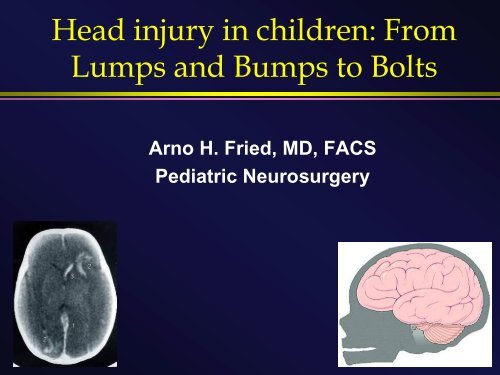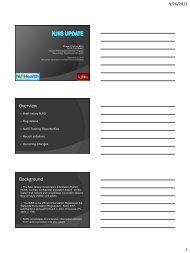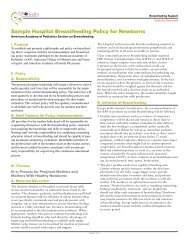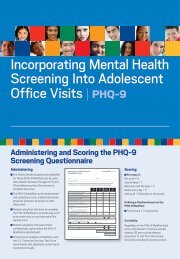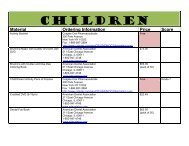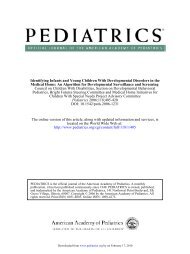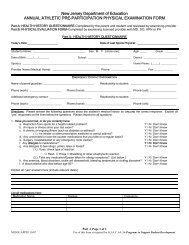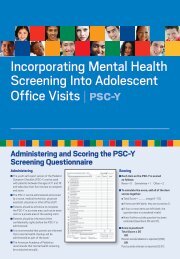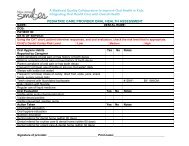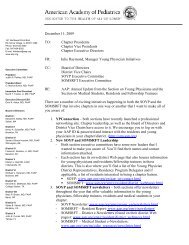Head injury in children: From Lumps and Bumps to Bolts
Head injury in children: From Lumps and Bumps to Bolts
Head injury in children: From Lumps and Bumps to Bolts
- No tags were found...
Create successful ePaper yourself
Turn your PDF publications into a flip-book with our unique Google optimized e-Paper software.
<strong>Head</strong> <strong><strong>in</strong>jury</strong> <strong>in</strong> <strong>children</strong>: <strong>From</strong><strong>Lumps</strong> <strong>and</strong> <strong>Bumps</strong> <strong>to</strong> <strong>Bolts</strong>Arno H. Fried, MD, FACSPediatric Neurosurgery
<strong>Head</strong> Injury <strong>in</strong> Children• 300/100,000 per year• Lead<strong>in</strong>g cause of death <strong>in</strong> <strong>children</strong>• Car accidents most common• Falls, bike, skateboard, sports• Non-accidental Trauma
Mild head Injury (MTBI)• “D<strong>in</strong>g” - mild concussion• 50 <strong>to</strong> 70% have postconcussivesymp<strong>to</strong>ms after 8 weeks• Possibility of permanentcognitive effects after 2concussions• When <strong>to</strong> return <strong>to</strong> play<strong>in</strong>g• Amount of cerebral reserve
Glascow Coma Scale(Modified for Young Children)• Best verbal response (1-5)1 none2 restless, agitated3 persistently irritable4 consolable cry<strong>in</strong>g5 appropriate words,smiles, fixes + follows
Age <strong>and</strong> Mortality• Mortality lessthe younger theage, except 1 styear of life• Only 10%<strong>in</strong>cidence ofsurgicalhema<strong>to</strong>ma (50%<strong>in</strong> adults)
Outcome severe childhoodhead traumaOutcome <strong>in</strong> <strong>children</strong> follow<strong>in</strong>g severehead <strong>in</strong>juriesJ Neurosurg 1978 May;48(5):679-88Bruce DA, Schut L, Bruno LA, WoodJH, Sut<strong>to</strong>n LN.• 8% mortality; GCS 5 <strong>and</strong> above allsurvived
Time L<strong>in</strong>e <strong>to</strong> RecoveryAfter Severe <strong>Head</strong> Injury• Eye open<strong>in</strong>g first– 1 <strong>to</strong> 2 months• Followcomm<strong>and</strong>s• Speech – can be6 months
Newborn <strong>Head</strong> <strong><strong>in</strong>jury</strong>• Cephalohema<strong>to</strong>ma• Ten<strong>to</strong>rial posteriorfossa subduralhema<strong>to</strong>ma• Subgalealhemorrhage• P<strong>in</strong>g pong fracture
Skull fracture• L<strong>in</strong>ear• Basal• P<strong>in</strong>g pong• DepressedClosedOpen
P<strong>in</strong>g Pong Fracture• Early <strong>in</strong>fancy• Elevate throughburr hole only
Grow<strong>in</strong>g skull fracture• Lep<strong>to</strong>men<strong>in</strong>gealCyst• Infancy• Skull fracture withdural tear• Sac of CSF <strong>and</strong>bra<strong>in</strong> develops <strong>in</strong><strong>to</strong>fracture l<strong>in</strong>e• Re-exam<strong>in</strong>e <strong>in</strong>fantsafter skull fracture
Grow<strong>in</strong>g skull fracture
Lep<strong>to</strong>men<strong>in</strong>gocele cyst
Depressed skull fracture• Double density• Open vs. closed• Dural tear• Epilepsy• Operate whenopen <strong>and</strong> > 5mm.
Posterior Fossa SubduralHema<strong>to</strong>ma• Occurs <strong>in</strong>newborns• Follow Hgb• Rarely needssurgery• May develophydrocephalus• Full term babies
Subdural hema<strong>to</strong>ma• Follows con<strong>to</strong>urof bra<strong>in</strong>• Associated withbra<strong>in</strong> contusion<strong>and</strong> burst lobe• Higher mortality<strong>and</strong> morbidity
Subdural hema<strong>to</strong>ma
Subdural hema<strong>to</strong>ma• Bridg<strong>in</strong>g ve<strong>in</strong>s<strong>in</strong><strong>to</strong> sagittals<strong>in</strong>us
Subdural hema<strong>to</strong>maremoval
Epidural hema<strong>to</strong>ma• Little bra<strong>in</strong> <strong><strong>in</strong>jury</strong>• Time is critical• Middlemen<strong>in</strong>geal artery• Skull fracture• Shock <strong>in</strong> <strong>in</strong>fants
Epidural hema<strong>to</strong>ma
Epidural hema<strong>to</strong>ma• Lens shaped• + /- Skullfracture• Shift
Epidural hema<strong>to</strong>ma
Subdural versus Epidural
Contusion• Basal frontal<strong>and</strong> temporallobes• Can develop <strong>in</strong><strong>to</strong>a hema<strong>to</strong>ma• Increased ICP
Contusion• Coup – contracoup <strong><strong>in</strong>jury</strong>
Focal Injury – Basal Contusion• Is usuallyfrontal ortemporallobe
Ten<strong>to</strong>rial herniation• Uncus oftemporal lobecompressesbra<strong>in</strong> stem• 3 rd nerve• Kernohan’snotch
Cerebellar herniation• Cerebellar<strong>to</strong>nsils herniatedthrough foramenmagnum• Medullary failure<strong>and</strong> respira<strong>to</strong>ryarrest• Posterior fossamass
Cerebral herniation• Durethemorrhage• Caused by bra<strong>in</strong>stem dis<strong>to</strong>rtion
Diffuse axonal shear <strong><strong>in</strong>jury</strong>• Common <strong>in</strong><strong>children</strong>• T<strong>in</strong>y axonaltears <strong>and</strong>hemorrhagethrough whitematter , corpuscallosum,cerebellarpeduncle
Cerebral swell<strong>in</strong>g• Increased blood volume, Notedema• Usually transient• ICP <strong>in</strong>creased• “childhood concussionsyndrome”• CT – ground glass appearance
Cerebral edema• Increased bra<strong>in</strong>tissue water• Vasogenic• Cy<strong>to</strong><strong>to</strong>xic• Increased ICP
Cerebral edema
Shaken baby syndrome• Severe shak<strong>in</strong>g<strong>and</strong> impact –acceleration /deceleration• Intracranialhemorrhage <strong>and</strong>edema• Ret<strong>in</strong>alhemorrhages
Shaken baby syndrome• Subdural mostcommon, oftenbilateral• Posterior<strong>in</strong>terhemisphericSDH• Severe cerebraledema
Non-accidental headtrauma
Shaken baby syndromeBilateral subdural hema<strong>to</strong>masSubdurals dra<strong>in</strong>ed with atrophy
Fat Embolism• Diffuse whitematter petichae• Long bonefracture• Increased ICP
MTBI <strong>and</strong> Football• 60’s work of Dr. Schneider• Transmitted force from verteximpact - “spear<strong>in</strong>g”• changed helmet design• rule changes• Cervico-medullary <strong>and</strong> C sp<strong>in</strong>alcord <strong>in</strong>juries
Postconcussive syndrome• <strong>Head</strong>ache, irritability, <strong>in</strong>ability <strong>to</strong>concentrate, sleep abnormalities,dizz<strong>in</strong>ess• Resolves over 6 <strong>to</strong> 8 weeks
Cumulative Injury• Effect of concussion morepronounced after second MTBI• Tim<strong>in</strong>g between 2 concussionsimportant <strong>to</strong> development of longlast<strong>in</strong>g effects• Box<strong>in</strong>g <strong>in</strong>juries - “dementiapugilistica”progressive dementia, movementdisorder, tremor, cognitive <strong>and</strong>psychiatric symp<strong>to</strong>ms
Concussion classification• Grade 1 - Mild confusion, NoLOC, resolves <strong>in</strong> 15 m<strong>in</strong>utes• Grade 2 - Amnesia, No LOC,symp<strong>to</strong>ms > 15 m<strong>in</strong>utes• Grade 3 - LOC > 5 m<strong>in</strong>utes, oramnesia >24 hours
Second impact syndrome• potentially fatal• athlete susta<strong>in</strong>s second blow <strong>to</strong> thehead before completely recover<strong>in</strong>gfrom a first concussion• Diffuse swell<strong>in</strong>g, loss ofau<strong>to</strong>regulation• Pt. Collapses with dilated pupils <strong>and</strong>herniation after walk<strong>in</strong>g around dazed• <strong>children</strong> <strong>and</strong> teenagers moresusceptible
Return <strong>to</strong> Competition• Grade 1observe for 20 m<strong>in</strong>utes.Return if all symp<strong>to</strong>ms are goneif not gone <strong>in</strong> 20 m<strong>in</strong>utes, no playfor 1 week <strong>and</strong> if asymp<strong>to</strong>matic
Return <strong>to</strong> Competition• Grade 2term<strong>in</strong>ate playreturn after 1 asymp<strong>to</strong>matic weekat rest <strong>and</strong> with exertionafter 2nd MTBI, hold for 2asymp<strong>to</strong>matic weeks or for seasonif any MRI abnormalities
Return <strong>to</strong> Competition• Grade 3term<strong>in</strong>ate playgo <strong>to</strong> hospitalcan return <strong>to</strong> play after 1 asymp<strong>to</strong>maticweek or 2 weeks if symp<strong>to</strong>ms wereprolongedAfter 2nd , hold for 1 asymp<strong>to</strong>maticmonthAfter 3rd, consider no further contactsports
Pediatric <strong>Head</strong> Trauma• Coma due <strong>to</strong>:Bra<strong>in</strong>stem compression due <strong>to</strong><strong>in</strong>creased ICPBilateral cerebral <strong><strong>in</strong>jury</strong> – diffuseaxonal <strong><strong>in</strong>jury</strong>Metabolic etiologySeizure
Intracranial pressure• Cush<strong>in</strong>g’s triadBradycardiaHypertensionElevated ICP
Pressure volume curve• Exponential• High complianceat low ICP• Low complianceat higher ICP(tight bra<strong>in</strong>)• Volumebuffer<strong>in</strong>gcapacity
Pressure Volume Index• PVI is theoreticalvolume needed <strong>to</strong>raise ICP 10 fold• L<strong>in</strong>ear relationshipbetween volume<strong>and</strong> ICP• Useful cl<strong>in</strong>icalmeasur<strong>in</strong>g <strong>to</strong>ol <strong>to</strong>determ<strong>in</strong>e bra<strong>in</strong>tightness
ICP Waves• A WavePlateau wave50 <strong>to</strong> 100 mm Hg10 <strong>to</strong> 20 m<strong>in</strong>utesVasodilatationLow complianceCan be fatal
Orig<strong>in</strong> of “A” Waves• Low compliance –tight bra<strong>in</strong>• ICP goes up• Cerebral perfusionpressure falls• Vasodilatation <strong>to</strong>compensate bloodflow• ICP de-stabilizes
ICP Waves• B WavesOccur at elevatedbasel<strong>in</strong>e ICP10 <strong>to</strong> 40 mm HgOne per m<strong>in</strong>uteCheyne s<strong>to</strong>kesrespiration?
Severe head <strong><strong>in</strong>jury</strong> – ICPmoni<strong>to</strong>r<strong>in</strong>g• GCS 8• DAI• Basel<strong>in</strong>e ICP 18-20• Low PVI (tightbra<strong>in</strong>)• Plateau occurs
ICP Moni<strong>to</strong>r<strong>in</strong>g• Multiple “A”Waves• Very lowcompliance• Oftenuncontrollable<strong>and</strong> fatal
Hyperventilation• Lower CO2 results<strong>in</strong> lower CBF <strong>and</strong>ischemia• Can be used asemergencymeasure• Consider xenon CTor jugular venousO2 moni<strong>to</strong>r
Hyperventilation <strong>and</strong>IschemiaXenon CT scansNormocapnia – normal blood flowPCO2= 38Hyperventilation – IschemiaPCO2=24
Management of IncreasedICP• Sedation <strong>and</strong> paralysisPropofol <strong>and</strong> Sevoflurane• Controlled ventilation• Normal CO2 – Eucapnia• Normovolemia• Controlled hypothermia• No steroids• Pa<strong>in</strong> control
Management of IncreasedICP• Manni<strong>to</strong>l - .25 <strong>to</strong> 2 grams per kg,Q 4-6 hrs.Keep serum osm 310 <strong>to</strong> 315• 3% hyper<strong>to</strong>nic sal<strong>in</strong>e• Lasix• Lidoca<strong>in</strong>e• Normal serum glucose• Ventricular dra<strong>in</strong>age
Management of Increased ICP• Bra<strong>in</strong> surgeryDecompressionHemicraniec<strong>to</strong>myLobec<strong>to</strong>myHema<strong>to</strong>ma evacuation
Management of Increased ICP• Pen<strong>to</strong>barbital ComaMaximal conventional <strong>in</strong>terventionEEG suppressionBP <strong>and</strong> cardiac output support
Bra<strong>in</strong> Compliance <strong>and</strong> ICP• Child normally hassteeper pressurevolumecurve• Trauma shiftscurve <strong>to</strong> left(steeper)• Rx shifts PV curveback <strong>to</strong> right
Aggressive treatment ofsevere head trauma• Ventriculardra<strong>in</strong>age• Manni<strong>to</strong>l• Paralysis• Normalization ofPVI• Pen<strong>to</strong>barb coma
Aggressive treatment ofsevere head trauma
Types of sp<strong>in</strong>e <strong>in</strong>juries• SCIWORA• Atlan<strong>to</strong>-occipital• Odon<strong>to</strong>id, Dens• C1/C2 rota<strong>to</strong>ry subluxation• Lower cord <strong><strong>in</strong>jury</strong>• Fracture +/- subluxation• Hema<strong>to</strong>ma• Disc herniation
Clear<strong>in</strong>g the child’scervical sp<strong>in</strong>e• Normal neuro exam• Lack of pa<strong>in</strong>• Good quality lateral cervicalsp<strong>in</strong>e XrayLack of fx or subluxationno signs of ligamen<strong>to</strong>us<strong>in</strong>stabilityNo prevertebral swell<strong>in</strong>g
Normal C sp<strong>in</strong>e
Open mouth C2 viewsA-O junctionC1DensC2
C sp<strong>in</strong>e open mouth view
Atlan<strong>to</strong>-occipitaldislocationBasion <strong>to</strong> tip ofdens < 12 mm
Odon<strong>to</strong>id growth center
C2 - C3 Pseudosubluxation
SCIWORA• Sp<strong>in</strong>al cord <strong><strong>in</strong>jury</strong> withoutradiologic abnormality• Mostly young <strong>children</strong>, 8 yrs orless• Upper cervical cord <strong><strong>in</strong>jury</strong>, canbe thoracic also• High percentage of completecord <strong>in</strong>juries
Correctable problems• Epidural hema<strong>to</strong>ma• Ruptured disc• Correct <strong>in</strong>stability• Associated pathology(pathologic fracture)
C1/C2 Rota<strong>to</strong>rysubluxation• M<strong>in</strong>ormechanism of<strong><strong>in</strong>jury</strong>• Torticollis;“cock-rob<strong>in</strong>”head position• Traction,analgesia
Lap belt <strong>in</strong>juries• Upper lumbar• Lap belt withoutshoulder strap• Associated withsmall bowelrupture• Horizontalfracture(Chance)
Clear<strong>in</strong>g cervical sp<strong>in</strong>e <strong>in</strong><strong>children</strong>• Awake; no pa<strong>in</strong> - simple C series• Awake, pa<strong>in</strong> - C sp<strong>in</strong>e series, thenconsider flexion extension views, +/-CT scan• Not awake - C sp<strong>in</strong>e series normal, CTscan normal - sp<strong>in</strong>e cleared. Ifquestionable f<strong>in</strong>d<strong>in</strong>g consider flexion- extension under fluoro.
• Mechanism of <strong><strong>in</strong>jury</strong> evaluatedfirst• Awake or lethargic orunconscious• Exam - pa<strong>in</strong>, tenderness,neurologic• SCIWORA - full evaluation,Xrays, CT, MRI, flex-extension• If <strong>in</strong>tubation needed proceedbefore C sp<strong>in</strong>e evaluation.Clear<strong>in</strong>g cervical sp<strong>in</strong>e <strong>in</strong><strong>children</strong>
Rehabilitation• Spasticity - Intrathecal baclofanpump• Sp<strong>in</strong>al cord rehab center• Cardiovascular - au<strong>to</strong>nomic• PreventionTh<strong>in</strong>k first for kids


